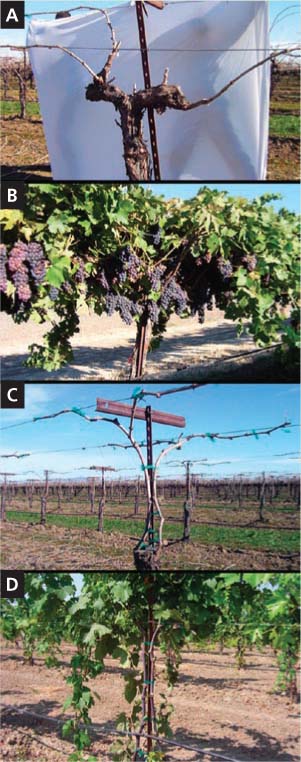All Issues
Sidebar: Vine surgery tested as management strategy for
Publication Information
California Agriculture 62(4):164-164. https://doi.org/10.3733/ca.v062n04p164
Published October 01, 2008
PDF | Citation | Permissions
Full text
The Sutter Home Vineyard in Arbuckle (Colusa County) was planted in 1988 and 1989 with a high-yielding selection of Zinfandel' (for white ‘Zinfandel’ production) on ‘Freedom’ and ‘Harmony’ rootstocks at 7-foot-by-12-foot spacing, with an 18-inch cross-arm. The vineyard encompasses 1,082 planted acres and has historically been pruned sequentially (by block) starting with block 1 around mid-December and finishing block 6 in early February. In 2000, we began noticing erratic budbreak and stunted spring shoot growth in the blocks that were pruned early. These symptoms were visually identified as Eutypa lata infections. When Russell Molyneux with the U.S. Department of Agriculture's Agricultural Research Service in Albany was unable to extract Eutypa metabolites via high-pressure liquid chromatography (HPLC) from cane samples taken at Arbuckle, we began questioning this diagnosis.
At about that time, the American Vineyard Foundation (AVF) Eutypa Research Project released a study by Epstein and VanderGheynst indicating that Botryosphaeria (Bot), not Eutypa, was the primary cause of spur dieback in some Central Valley vineyards. This work was later confirmed in vineyards located throughout California (Urbez-Torres et al. 2006). In 2004, the Sutter Home Vineyard management group teamed up with Epstein's UC Davis lab to identify and evaluate the organisms causing dieback at Arbuckle and to develop a management strategy to deal with diseased vines.
Epstein, VanderGheynst and Kaur made numerous visits to confirm that Botryosphaeria was the organism causing spur dieback, evaluate potential sources of infection, conduct wound treatment trials and monitor spore release. They observed that deadwood on the cordon and prunings left under the vine (on the berm and between the vine rows) were covered with Botryosphaeria pycnidia and were the likely source of spore release and continuing Botryosphaeria vine infection. The Epstein group initiated a vineyard sanitation trial (see page 161) to quantify Botryosphaeria spores in vineyards with minimal and recommended sanitation. Recommended sanitation includes the removal of dead-wood from the vine and either burial or removal of prunings from the vineyard floor. Sanitation appears to be useful for suppressing the initiation of new Botryosphaeria infections. The removal of Botryosphaeria-infected wood from the vine was approached in a couple of ways. The first trial consisted of removing the cordon near the first healthy spur on either side of the stake and switching from spur to cane pruning (see photo A). This approach involved severing the cordons, painting the wounds, disconnecting the cordon wire from the stakes, removing the cordons and cordon wire from the vineyard (burning is an acceptable vine disposal method in Colusa County) and installing a cane wire. This strategy allows for continuous cropping (see photo B) and may be a good way to deal with a mild Botryosphaeria infection.
Severe Botryosphaeria infections may require a different approach. We have successfully left the infected cordons in place and utilized cane pruning with the remaining healthy and productive wood. However, when the per-acre yield per block falls below an economically viable level, severe vine surgery (as opposed to vineyard replanting) will allow vines to stay in the ground and most of the trellis and drip irrigation system to remain intact. The cost for cutting vines above the graft union and about 12 inches from the ground (see photo C), removing and disposing of the upper portion of the vine and the cordon wire, painting the wound, reinstalling a new cordon wire, retraining and tying the vine, repairing trellises and conducting standard farming activities was about $4.20 per vine or about $2,200 per acre. This method should yield almost a full crop in the second year (see photo D). We are currently evaluating several training practices with the use of either two trunks to reestablish bilateral cordons or quadrilateral cordons, or training the vine for cane pruning (see photo D).
In ‘Zinfandel’ vines mildly infected with Botryosphaeria obtusa, (A) infected cordon wood was removed, and cane pruning replaced spur pruning and (B) regrowth was treated by removing the cordon portion with dead spurs; in severely infected vines, (C) almost all of the scion was removed and new canes were trained and (D) most of the cordon was removed.
Time will determine if severe vine surgery is successful in reestablishing vineyards infected by Botryosphaeria. RH Phillips vineyard managers initiated this approach to vineyard revitalization several years ago at a planting about 10 miles south of the Arbuckle vineyard with vines apparently suffering from Botryosphaeria infection, and the retrained vines still seem to be vigorous and productive.





